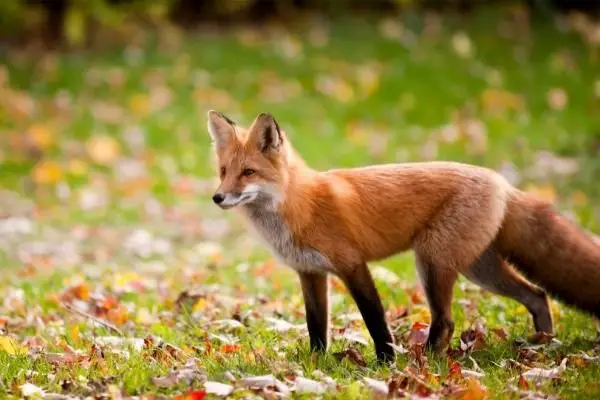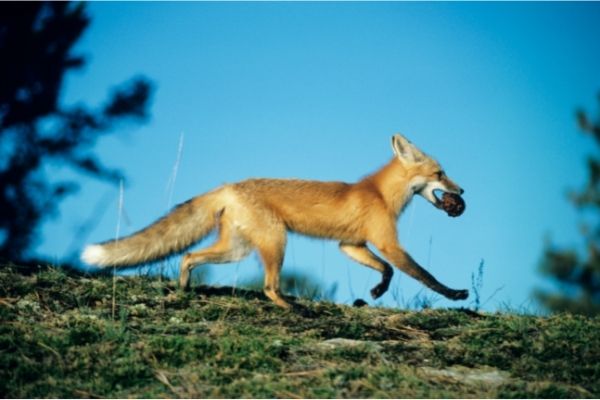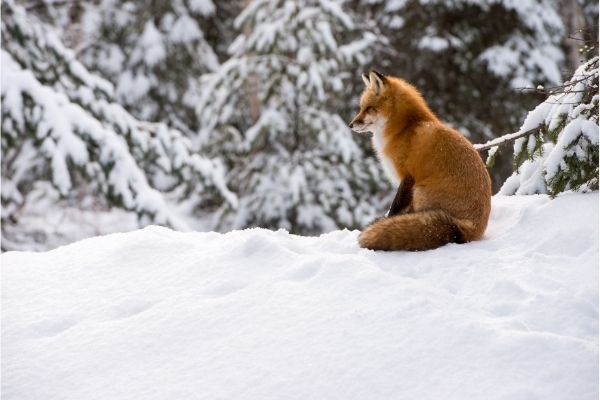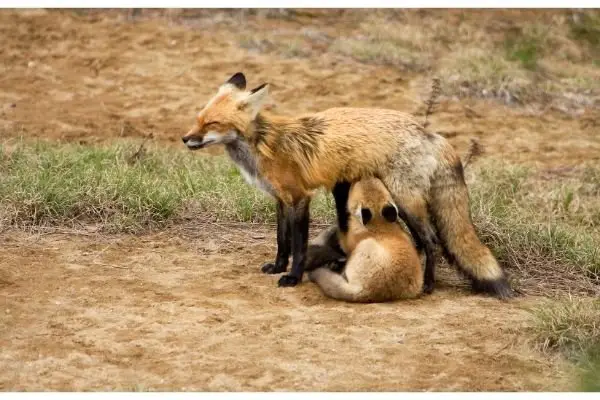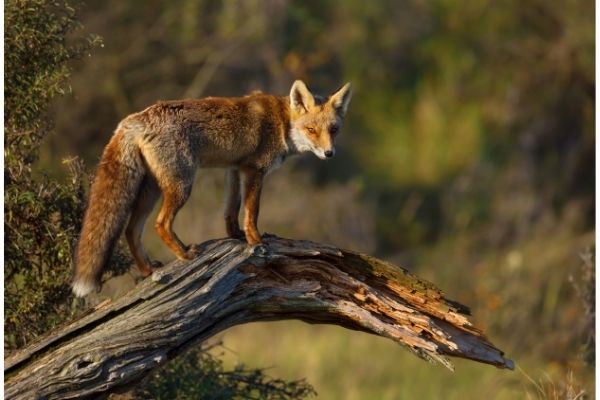Red Foxes are abundantly found in the Northern hemisphere. Known for stealing chickens, Red Foxes play a vital role in protecting the crops by hunting crop-destroying small mammals and insects. We have listed down complete Red Foxes Facts for Kids that will help you in learning all about Red Foxes. You are going to learn about its scientific name & classification, evolution, appearance, physical features, physical abilities, diet, habitat, lifespan, reproduction, babies, behavior, adaptations, food chain, ecological role, endangerment, population, predators, and many other interesting facts about Red Fox.
Red Fox Facts For Kids
What Is A Red Fox
- The red fox, also known as the common fox is the largest species of true foxes.
- The red fox is widely distributed across the entire Northern Hemisphere including North America, Europe, Asia, and parts of North Africa.
- It belongs to the Canidae family and has the largest natural distribution of any land mammal other than human beings.
- Red fox lives in many diverse habitats including forests, mountains, grasslands, and even in deserts.
- It also adapts well to human environments and lives in areas such as farms, suburban areas, and even largely populated areas.
- The red fox is a famous subject of folklore as a symbol of animal cunning.
- Due to its large population and widespread distribution, the red fox is one of the most important fur-bearing animals harvested for the fur trade.
Scientific Name
- The scientific name for Red Fox is Vulpes vulpes.
Scientific Classification
The following is the scientific classification of the red fox:
| Kingdom | Animalia |
| Phylum | Chordata |
| Class | Mammalia |
| Order | Carnivora |
| Family | Canidae |
| Sub-family | Caninae |
| Genus | Vulpes |
| Species | V.vulpes |
Evolution
- Genetic analysis indicates that red fox emerged from two separate lineages that were isolated nearly half a million years ago.
- Evidence confirms that the red fox originated from smaller-sized ancestors from Eurasia during the Middle Villafranchian period after which they colonized North America.
- The red fox represents a more advanced form of carnivory among the true foxes.
- However, the red fox is not adapted for a purely carnivorous diet like the Tibetan fox.
What Does A Red Fox Look Like
Appearance
- The red fox is the largest animal among true foxes.
- It has an elongated body with dense, silky red fur along the face, back, and tail.
- Its tail is longer than half of its body length.
- Red foxes have relatively short limbs, their feet are black and they have large pointy ears.
- Their forepaws have five digits, while the hind feet have only four and lack dewclaws.
- Their throat, chin, and belly are greyish while their tail is fluffy with a white tip.
- The red fox has a narrow, elongated skull with small braincases.
- It has a long jaw with sharp, pointy teeth.
- It has oval pupils that are vertically oriented.
- The red fox is a sexually dimorphic species and male individuals are usually bigger than females.
Color
- The usual color for red fox is rich reddish-brown.
- The range of coloration in red foxes represents stages towards full melanism and mostly occurs in colder regions.
| Color morph | Description |
| Red | Typical coloration |
| Grey | Grey spine with reddish-brown limbs |
| Blackish-brown | It is the melanistic color morph of the Eurasian red fox. Reddish fur is almost absent. |
| Silver | It is the melanistic color morph of the North American red foxes. Usually pure black with silver skin. |
| Platinum | Pale silvery-white fur with a bluish shade |
| Samson | Woolly pelt and lack of guard hairs |
Physical Features
Height
- The height of an adult red fox is about 35-50 cm.
Weight
- An adult red fox typically weighs about 5–7 kg (10–15 lbs). The heaviest recorded specimen was 17.2 kg (38 lbs).
Length
- The body length of red foxes is generally about 90–105 cm (36–42 inches).
- Their tail is about 35–40 cm (14–16 inches).
Fur
- The red fox has dense, silky fur which is relatively longer in northern red fox than in southern red fox.
- Typically, a red fox has bright, rusty-red fur. But it varies from place to place.
- Its thick red fur has always been in demand that is why humans have been hunting it for thousands of years.
Physical Abilities
Speed
- Red foxes can run as fast as 50km/h (31 mph).
Jump
- Red fox can jump up to 3 feet. Their claws enable them to jump even higher than 6 feet.
Climb
- Red foxes are great climbers. They can climb trees that are straight up.
- They also climb fences to get to their prey.
Swim
- Red foxes are known to be great swimmers.
Habit
- Red foxes are solitary hunters but have a flexible diet because of their flexible home environment.
- They communicate with each other using scent marks and urine.
- They are extremely cunning and can get what they want even by underhanded means.
Senses
- The red fox has great eyesight. This is because of their vertically slit pupils much like a cat’s.
- It has excellent hearing. It can hear a mouse squeak 100ft away. It also has a great sense of smell as it uses these two senses in locating its prey.
- Unlike most animals, red foxes have an underdeveloped sense of taste with fewer sour-sensing taste buds.
Communication
- Red fox communicates with each other through sounds, such as yelping, growling, and short yapping barks.
- It also communicates by urinating at various spots to tell other foxes in the area that it is present.
What Do Red Foxes Eat
- Red foxes are solitary hunters. They mostly feed on rabbits, mice, birds, frogs, and other small animals and insects.
- They are also fond of eating fruits and vegetables, fish, frogs, and even worms.
- Red foxes will happily dine on garbage and pet food if they are living among human beings.
- They are smart at finding food, even during winters.
Diet
In Wild
- Red foxes have a diverse diet. Their diet ranges from eating the meat of rodents, rabbits, birds, frogs, etc. to feeding on fruits and vegetables.
In Captivity
- In captivity, red foxes will feed on anything even if it is garbage food.
- They also eat pet food and raw meat.
List Of Food Items
- Rabbits
- Rodents
- Squirrels
- Birds
- Frogs
- Caterpillars
- Grasshoppers
- Beetles
- Crayfish
- Fruits
- Berries
- Grasses
How Much Red Foxes Eat Per Day
- Red foxes can eat up to several pounds of food per day.
What Do Baby Red Fox Eat
- Baby red fox mostly feeds on invertebrates including grasshoppers, beetles, and caterpillars. They also eat small mammals such as squirrels and mice.
Where Do Red Foxes Live – Red Fox Habitat
Natural Habitat
- The red fox is indigenous to the Northern Hemisphere, including most of North America, Europe, and Asia.
- They have also been introduced to the Falkland Islands and Australia.
- They are mostly found in forests, grasslands, mountains, and deserts.
- They live at an elevation of 4,500 meters from sea level.
- Red foxes also adapt well to human environments and prefer mixed vegetation communities.
- They can be found in populated areas such as rural, suburban areas, and even farms.
Biome
- Red fox lives in the grassland or savanna, forest, and desert or dune biome.
Range
- The red fox is the most widely distributed species of Canidae.
- The habitat range of red foxes includes most of the United States and Canada.
- They can be found throughout New Hampshire, Central America, and northern Africa.
- Red foxes are also found in Europe and Asia and have been introduced to Australia.
Countries List
- The habitat range of red foxes includes the following countries:
- The United States of America
- Canada
- Australia
- Italy
- Africa
- The United Kingdom
- Tajikistan
- Uzbekistan
- Denmark
- Iceland
Red Fox Life Cycle
- The life cycle of the red fox starts when it is born after a gestation period of 51 to 53 days.
- Female red foxes attain sexual maturity at the age of 10 months while male red foxes reach sexual maturity at a later time.
- Red foxes breed mostly between January and March.
- Right after mating, the female makes one or more dens. The extra dens are to be used if the original den is distributed.
- The female then gives birth to 10-13 pups.
- The pups leave the mother after they are about 7 months old.
- They have an average lifespan of about 3 years in the wild and up to 12 years in captivity.
Red Fox Lifespan
In Wild
- Red foxes have an average lifespan of about 3 years in the wild.
In Captivity
- Red foxes can live up to 10-12 years in captivity.
- The oldest red fox to ever live in captivity was 33 years old.
Red Fox Reproduction
- Red foxes are monogamous, which means that one male individual mates with one female individual.
- They breed once a year during the spring season.
- After mating, the female makes a den for its pups, to which the male is not allowed to enter.
- The gestation period lasts for about 53 days after which the female gives birth to about 13 pups.
- The pups are initially born blind but open their eyes within the first two weeks.
- The male provides food for the pups while they stay in the den for four to five weeks.
- The mother teaches the pups multiple hunting skills using live food to play with.
Red Fox Male Vs Female
- A male red fox is called a dog while the female red fox is called a vixen.
- Male red foxes are larger than female red foxes.
- Females raise their pups by teaching them hunting skills while males provide food for them.
- Most males only breed with a single female, but some males breed with multiple females.
The behavior of Red Fox
- Red foxes are nocturnal, which means they are more active during the night. Although, they might hunt during the day as well.
- They are highly territorial animals and use their urine to mark their territory.
- Their urine is also used to mark empty cache sites where they store their food.
- Red foxes share joint territories as they live in family groups.
- They groom themselves by licking. Their oily saliva cleans and oils their bodies. They also lick each other as their cleaning ritual.
- They usually leave their families once they reach adulthood if they can establish their own territory. If not, they will stay with their parents and postpone their reproduction.
- Except for breeding females, the red fox doesn’t usually use a den. Instead of making its den, it will find an abandoned rabbit or marmot den.
Red Fox Baby
- A baby red fox is called a kit, pup, or cub.
- The kit is born blind and cannot open its eyes until it is about 2 weeks old.
- For the first month, kits will only drink their mother’s milk. They then also start eating pre-chewed food.
- During their time in the den, they learn hunting skills from their mother.
- At the age of about seven months, red foxes become able to hunt themselves and become independent.
Red Fox Adaptations
Structural and Physical Adaptations
Dense Fur
- The red fox has thick and dense fur that helps them stay warm during the winter times.
- Their fur color usually blends in with the surroundings and provides them camouflage.
Slender Body
- Red foxes have small and slender bodies designed for speed and agility.
Large and Pointy Ears
- Red foxes have big pointy ears responsible for their excellent hearing.
- Their hearing is so sharp that they can hear the squeaking of mice about 100ft away, the flight of crows at the distance of 0.25 to 0.5 km, and black grouse that are changing roosts at the distance of about 600 paces.
Long legs
- Red foxes have long legs which help them climb trees and fences.
- Their small stomachs and long legs help them to run as fast as 48 km/h (30 mph).
Thick Tail
- The red fox has a thick tail covered with long fur, which it uses as a warm blanket.
- The tail also helps the red fox to balance the body during movement.
- Apart from that, red foxes also communicate with each other by waving their tails.
Behavioral Adaptations
Strong Senses
- Red foxes have strong senses. They have a sharp vision which is about the same as a cat’s vision.
- They can also hear very well. Red foxes can pick on low frequencies, making it easy for them to go after tiny creatures.
Fast Running
- Red foxes are fast runners, thanks to their long legs and slender bodies.
- When faced with predators, red foxes can easily flee the threatful situation by running away.
- Their speed also makes them excellent hunters because they can catch their prey almost always.
Stashing Food
- An important survival adaptation of red foxes is that they stash away excess food for later use.
- Red foxes bury the extra food into the ground, whether in soil or snow.
- They hide their food in layers of grass or foliage and urinate over it to mark it as theirs.
Red Fox Food Chain
- The red fox is present at the top of the food chain as it is an omnivore. It feeds on both plants and animals.
- Red foxes are Tertiary consumers, they feed on producers (plants, fruits, etc.), Primary consumers (worms, grasshoppers, etc.), and Secondary consumers (rodents, rabbits, etc.).
Ecological Role Of Red Fox
- The red foxes are keystone species in areas where they are naturally distributed.
- They help to control the populations of their prey animals, such as mice, etc.
- They also disperse seeds as they eat a lot of fruits.
- They also contribute to the economy in areas where their fur is sold.
- In farms, red foxes help the ranchers and farmers by keeping the number of rodents in check.
Population
- The estimated worldwide population of red foxes is 258,000 individuals.
Red Fox Endangerment
Reasons
- The red fox is not an endangered species, however, excessive hunting of red foxes for fur trade is a big threat to the species.
- Habitat loss is another threat to the survival of red foxes.
Conservation Status
- The conservation status of the red fox on the IUCN Red List as Least Concern.
Diseases and Parasites
- Red foxes harbor a range of different parasites.
- They are carriers of both internal and external parasites, including various species of intestinal worms, flukes, heartworm, tick, mite, protozoan, viruses, bacteria, and fungi.
- Wounded red foxes are also susceptible to secondary bacterial infections such as Streptococcus and Myiasis.
Red Fox Predators
- Red foxes have the following predators:
- Long-tailed weasels (Mustela frenata)
- Skunks (Mephitis mephitis)
- Mink (Mustela vison)
- Snakes
- Owls (Strigiformes)
- Hawks
- Coyotes
- Wolves
Relationship with Humans
- Red foxes easily become used to human activity and even learn to ignore it.
- They wander around near populated areas in search of food and provide a litter clean-up service by eating the discarded food.
- They are very clever and can sense if there is danger or not which is why, if faced with people, they sit and watch instead of running away immediately.
- Some red foxes may even let children play with their cubs if they are used to being around communities.
- Red foxes are so adaptive that if you fed them food by hand or inside the house, they will come to the house unannounced and mark their territory which can lead to serious issues.
Red Fox Fun Facts
- Red foxes are considered to be the most widespread meat-eating mammals on the planet.
- They are very clever and intelligent animals and are famous for their cunning in folklore.
- They have long, fluffy tails which they use as a cover in winter.
- Their forepaws have five toes while their hind feet only have four toes.
- Red foxes have supersonic hearing, which means that they can hear sounds from 100 meters away.
- They grin when they are scared.
- Red foxes are hunted for sport and their fur.
- Red foxes adapt well to large communities but they cannot be tamed to be kept as pets.
FAQs
Are red foxes dangerous?
- Red foxes are not dangerous but they can be carriers for diseases.
How do red foxes behave?
- Red foxes are solitary hunters and feed on mammals such as rabbits and rodents.
- They mark their territory by urinating and communicate with each other by making scent posts.
Can Red Foxes be pets?
- Red foxes are not domestic animals and cannot be tamed as a pet.
Is a red fox an invasive species?
- Yes, the red fox is an invasive species, because it succumbs to rabies and other diseases.
How many red foxes are left in the world?
- There are a total of approximately 225,000 individuals left in the world.


